#also i know it uses the common rarity symbol but these lands are actually in the basic land slot
Explore tagged Tumblr posts
Note
You're more amazing than guns
Decided to finally add some lands to my set, plus adjust the enchantment signposts











#asks#custom cards#Bestowed Savior used to return to hand on death but had the issue of going infinite if you have any other bestow creature#just keep bestowing one onto the other and then you'll never lose either of them#this fixes that but also makes the card more powerful by keeping the creature on the board#i have no idea how powerful this effect is so it might just need to get reworked entirely#and i already mentioned how Faith Given Form can go infinite with another copy of itself so i just did the fix i mentioned#anyway since the artifact lands have indestructible i thought it'd be cute to give the enchantment lands hexproof#serves the same purpose of protecting against removal but it feels more enchantment-y and magical instead of physical#they haven't done enchantment lands and they haven't even put the bridge lands in a standard set but whatever#i'm tired of seeing boring weak dual lands so i wanted to do something kinda neat#i doubt it'll break anything#needed a black-green land to round out the cycle's color balance and it's more complicated than i'd prefer but oh well#also i know it uses the common rarity symbol but these lands are actually in the basic land slot#just like the crime lands in otj#i had slightly more complex ideas for the other color pairs so i put those in rare#gene jungle counts for both green-blue and blue-black
1 note
·
View note
Text
Ring of Gix is one of the few reserved list cards that actually has a gold rarity symbol. As information became more widespread and the internet became a more accessible tool in the home, there was less reason to hide the rarity of each card. Island was a rare in one of the first sets and that was meant to obscure rarity. Who would have guessed that a basic land would be a rare? Personally, I do not think that is healthy for the game. Making basic lands hard to get in order to confuse people about how rare each card was was not a winning formula. Thus, the era of hidden rarities ended and the urza block was the first block to have cards clearly labeled. Commons typically had a black symbol. Uncommon were silver and rares were gold. Even today, we still use these same colors to denote rarity. Mythic rare was eventually added but urza's block represented a shift in the game. All rares were defined. Everyone knew what cards were in lower supply which helped to contribute to the rise of the secondary market. Cards were not merely expensive because they were powerful but because the company defined them as scarce and rare. I like the transparency of knowing immediately if a card is rare. So is ring of gix a playable reserved list card? First, this card is outclassed by icy manipulator. Ring of Gix has the same exact ability but costs one less mana to cast. You may think this is an upgrade but this card also has an echo cost so you will actually need to pay 6 mana to keep the ring of gix around while icy manipulator only requires 4 mana and no upkeep. Icy manipulator is superior with the exception being if you only needed this effect for one turn. However if you only needed this ability one time then there are cheaper cards to accomplish that task. It looks like ring of gix was meant to be a weaker callback to icy manipulator as that was considered a very obnoxious card in old school mtg. Having to pay an echo cost really helps balance the effect. Yet, in our modern era, icy manipulator has experienced power creep. It was reprinted in dominaria and did not see any competitive play. If icy manipulator is no longer good enough then what does that say about ring of gix? Currently, ring of gix sees play in 0 percent of decks on edhrec. That is a shame because ring of gix can still function as a flavor card. It is a colorless artifact so you can play in anything. How about a gix flavored deck? Gix is a decent commander and tapping my opponents creatures will help me deal damage and draw. You might also play this in sauron decks. Sauron is lord of the rings and I can see a Sauron deck that uses a ton of cards with ring in the art or title. Hylda of the icy crown also might a continuous way to tap down creatures turn after turn. Overall, even when ring of gix first released, it was already outperformed. You don't always have to play an optimized deck though. Sometimes a nice flavor deck centered around a praetor is exactly what you need.
#gix#ring of gix#magic the gathering#magic the card game#youtube#commander legends#commander#mtg#blogatog#arena#mark rosewater#reserve list#tolarian community college#alpha investments#magic the gathering arena#magic arena#magic card game#magic#mtg arena#mtgstocks#mtg zendikar#mtgo#mtg commander#mtg art#flavor#phyrexia#new phyrexia#yawgmoth
1 note
·
View note
Text
How to Actually Play Magic: The Gathering
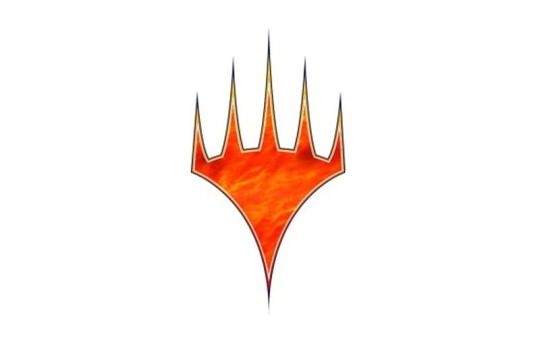
Magic: The Gathering (MTG, or just Magic) is the first and one of the most popular trading card games in the world. Described as the chess of card games, you can go as complex as you want (even make a computer) or have as much fun as you want, diving into the multitudes of worlds, creatures, and characters to express yourself.
But first you need to know how to play.
Lots of guides tend to be overly simplistic, so here I’ll try to go really in-depth in the rules while still maintaining an introductory tone. I will also try to provide as many pictures of relevant cards as possible to expose you to the vast array of effects cards may have, and how they interact with what I’m currently discussing.
1. The Colors of Magic

The most defining part of Magic are the five different colors. Each has its own flavor, playstyle, advantages, and disadvantages. You can combine different colors in your deck to have access to interesting combos and to balance out your deck’s weaknesses. Different color combinations also have their own specific flavor, often embodied by groups such as the guilds of Ravnica.
White: This is the color of unity, healing, and order. Cards in this color will often gain you life, protect your creatures from damage, tax or outright prevent your opponents from doing tricky things, and make armies of small creatures that together make mighty fighting forces. It is also associated with artifacts, enchantments, and exiling.
By the way, I will be defining Magic terms as they come up, like so.
Token: A representation of a creature, artifact, or something else. You can use it like a card while it exists, but it will vanish when it leaves the battlefield. (the rest of these terms will come up soon.)
Exile: Originally called “removed from the game”, exile is a zone that is inaccessible to most cards. It makes sure your opponents’ creatures go away forever. Sometimes, creatures go to exile and come right back to get extra enter-the-battlefield effects, known as blinking.
If you see something that isn’t immediately defined, just keep it in mind. Chances are I’ll cover it in a later chapter.
Blue: This color is related to knowledge, water, and the cold. You’ll get to draw lots of cards, but your creatures will be lacking. Instead, you will have access to powerful spells that bounce, freeze, or steal your opponents’ creatures and even give you extra turns. Quelch your opponents’ attempts with counterspells. It also has affinity for artifacts.
Black: This color represents death, disease, and ambition. Full of evil kill and discard spells, you will have access to your own army of zombies, vampires, and demons. You will also be able to do powerful things, but often at the cost of cards, creatures, or even your own health. In the words of Dark Confidant, “Greatness, at any cost.”
Red: This is the color of passion, fire, and explosive power. Many of the direct damage spells, including the iconic Lightning Bolt, are Red, as well as aggressive, fast creatures and multiple combats. You will have an extreme upper hand in your first few turns, but will quickly run out of gas if you don’t use another color to keep up on card draw. Red also brings with it mighty dragons and world-morphing chaotic effects.
Green: The color of nature, Green is similar to white in its abilities to heal, create tokens, and destroy artifacts and enchantments. However, Green has a wild side and is full of giant beasts, swarms of bugs, and rapid evolutions. It also brings out lands quickly and makes tons of mana.
2. Dissecting a Card

Sidisi is a popular character that hales from the plane of Tarkir. She’ll be helping us as a prime example of what a card looks like. There’s a lot to take in, but we’ll start from the top and work our way down.
First is the border (yes, from the very top!). It seems silly, but there are actually a few different borders that mean different things. A vast majority of cards have the regular black border. You may also see cards with white borders - these tend to be older cards, but they’re just as good as the black bordered ones. Silver borders come from the Un-sets, a series of joke sets full of wacky mechanics and inside jokes. None of these cards are tournament legal, but you’re free to have fun with them with your friends. Gold-bordered cards will also have a different back, and were printed as a part of tournament-winning decks back in the day. These are not tournament legal, but since they are often cheaper than their “real card” counterparts, people will use them in casual decks.

Next is the name. “Sidisi, Brood Tyrant” is the full, English name of this card. Each deck can only have up to 4 copies of any single card (there are very important exceptions to this I will cover in the next chapter). There are also a few cards which specifically reference others by name.
To the right of that is the mana cost. In this case, we need to use one black mana, one green mana, one blue mana (each represented by their respective symbol) and one mana which can be of any color, or even colorless, represented by the 1 in the circle. We’ll find out how to get mana in the next chapter as well. As a side note, many cards will consider the mana value (formerly, converted mana cost), which is just the total cost of the card as a number. For Sidisi, it’s four.
Beneath that is the art.

Arguably the most important part of any card, Magic’s art is what really sets it apart from other games. People fall in love with specific cards for their dramatic poses, mighty beings, and stunning vistas. The art brings character to every card, and ties flavor and function beautifully. This is the best way to express yourself, and find what you really like about Magic.

Next is a thin bar called the typeline. This will tell you first what type of card it is - either a land, creature, artifact, enchantment, planeswalker, instant, sorcery, or tribal (or some combination!), which dictate how you use the card, and what other cards interact with it. Card types can be divided into permanent, which go on the battlefield once played, and nonpermanent, which you play for a single effect and immediately go to your graveyard. There are also some supertypes. Sidisi herself is Legendary, meaning she represents a specific character from Magic lore. This also means you can only have a single copy of her on the battlefield at any one moment; if you somehow get another, you’ll have to sacrifice one. Basic is another important supertype we’ll cover soon.
On the other side of the hyphen is the subtype - this is almost exclusively used for creatures to tell you what tribes they belong to. Sidisi herself is a Naga and a Shaman, and will thus interact with cards that care about that (these are often called tribal effects; for example, “Elves you control get +1/+1″). From Trilobites to Trolls, the creatures of magic are a diverse crowd.
Finally comes the set symbol, that strange orange shield thingy to the right. This tells you two things: the set the card comes from, and the rarity. This specific symbol represents the set Khans of Tarkir, so booster packs from that set may contain Sidisi. Rarity comes in 5 different colors.

Black: Common (Simple, often weak)
Silver: Uncommon (May have cool mechanics)
Gold: Rare (More powerful and complex)
Orange: Mythic Rare (The most powerful and complex)
Purple: Special (This is only used in situations such as Time Spiral, where they reprinted cards in the old border)
The rarity often (but not necessarily) corresponds to power level. It’s better to think of it as a ranking of design complexity. Newer Rares and Mythics will also have that shiny, elliptical sticker near the bottom, which simply guarantees the authenticity of the card.

The bottom half of the card is dominated by the text box. This will tell you the effects and abilities of the card. Sidisi has two abilities: one that triggers whenever she enters the battlefield or attacks, and one that triggers whenever a creature card is put into the graveyard from your library (on modern cards, this is called milling). We will go over abilities later.
Notice how Sidisi aligns with her colors. As a Naga, she is Green. Her zombie tokens are characteristic of Black, and tokens are generally Green as well. Milling is a Blue ability, and putting creatures in the graveyard to bring back to life is definitely Black.
The text box is also home to flavor text, the italicized text beneath the rules. This will often be a little blurb or quote relating to the flavor of the card. Consider it an extension of the art.
Creatures will also have that rectangle to the bottom right, called the Power and Toughness. The first number is the power (how hard it punches) and the second is the toughness (how hard of a punch it can take). This is relevant for combat and we will cover it extensively later.
Finally come all those funny symbols at the very bottom. This will include the collector’s number (199/269), the set (KTK = Khans of Tarkir), the artist (Karl Kopinski) and the copyright.
3. Lands
Lands are by far the most important component of your deck. They are what generate the mana you need to cast your spells, and dictate the colors of spells you can play.
You can play one land per turn - just plop it from your hand onto the battlefield. They have no mana cost, and thus the top right is blank.
The Basic land is the prime exception to the four-card limit, as you can have as many as you want in your deck. The Basic supertype also interacts with several cards, such as ones which let you get more from your deck onto the battlefield.
The 6 basic lands are Plains (white), Island (blue), Swamp (black), Mountain (red), Forest (green), and Wastes (colorless, only used in decks such as Eldrazi Tron, and are often not included).

This cycle comes from Lorwyn, a set based in Gaelic mythology.
All Basic lands come with the implied rules text that they can tap to create one mana of their respective color, and as such will often have the cinematic mana symbol instead.
Tap: A common cost on a permanent to activate an ability. Turn the card sideways to tap it. It will stay tapped until your next turn, when it will untap during your untap phase (more on that later). A tapped card can’t be tapped again, and a tapped creature can’t block.
Some lands, especially those that can make different colors, will enter the battlefield tapped, so you’ll have to wait an extra turn to use them. Other lands might only create colorless mana (represented by a number on older cards and a diamond on newer cards), so they’re less useful for casting spells, but will have interesting abilities, such as:

This Mutavault can turn into a creature for just 1 mana, which you can use to attack and block with. (Pop quiz: see if you can recognize each part of the card!) There are dozens more examples that do everything from draw you cards to destroy your opponents’ pesky lands.
But what exactly does it mean to create a mana? Well, really, it gets added to your mana pool, as you may have noticed on the Mutavault. This is an arbitrary place where all your mana goes so that you can spend it. This isn’t often relevant, because you’ll mostly tap your lands while casting spells and the mana will immediately be used, but there are a few scenarios where it might be useful. For example, someone targets your land to destroy it because they don’t want you to have the mana open to kill something they’ll play next. Just tap your land to keep a mana “floating”. However, all the mana in your pool will automatically drain out each time you change phases (more on those later).
Tapping lands for mana is an ability, but since it’s a mana ability, it won’t use the stack, so you can use them just about whenever. More on the stack later as well.
Most decks will be around one-third lands, with more or less depending on how low the average cost of cards you have are. The less colors you run, the less cards you have at your disposal, but the more flexible your mana base can be - more colors often use lands that enter tapped and are inconsistent at drawing the colors they need.
Have fun experimenting with your mana base, especially in casual formats. In more competitive formats, lands are actually the most expensive cards! The top lands are called the shocklands, fetchlands, and original dual lands - the last of which are several hundred dollars each.
4. Permanents
Besides lands, just about every other card you play is considered a spell when you cast it (you’ll see this on cards such as Counterspell). However, for the sake of clarity, I’ll be using “Permanent” to refer to anything that goes directly on the battlefield once it resolves and “Spell” to refer to single-use cards.
Of the card types mentioned above, permanents include lands (which we just covered), creatures, artifacts, enchantments, and the mighty planeswalkers. I’ll include a visual example of each as we go.
Creatures are your basic way of winning the game. They can attack your opponent to take down their life total, but might also have interesting abilities that make them more valuable as repeatable spells than combatants.

Incubation druid is a great example of both: she starts off as an additional land, giving you more mana quicker to play your other cards. With 0 power, she’s useless as an attacker. However, her Adapt ability lets her grow into a formidable 3/5, so you can attack and block with her much more effectively later in the game. Notice the curved arrow symbol that represents tapping.
+1/+1 Counter: This is a permanent buff to your creature, giving it an additional power and toughness each. Counters in general can come in many forms: -1/-1 counters are self-explanatory, but ability counters such as a Flying counter give your creature a new keyword. Other counters, such as Lore and Filibuster, keep track of certain things for you. Always bring a few dice with you to every game, as you’re sure to want to track some sort of counter.
Creatures enter the battlefield with summoning sickness, which means they can’t attack or use any ability that requires them to tap until your next turn. Creatures also get summoning sick when they change control. A creature with Haste, a keyword ability, lets you ignore this, and is often found on red creatures.
Artifacts, lore wise, are artificial, sterile creations of wizardry, and as such, almost never correspond to a color. They may imitate the effects of a certain color, but to prevent other colors from having easy access to it, they will often be overcosted. A common type of artifact is colloquially known as the mana rock, as it generates mana. There are many cards that interact and enhance artifacts.

Hedron Archive is a typical mana rock, costing four mana of any color and boosting your mana generation ability by two. Later in the game, if you already have more than enough lands, you can cash it in for two mana to draw some more cards. Notice the distinct metallic border.
Artifacts often combine with Creatures to form Artifact Creatures, or less commonly with Lands to create Artifact Lands.
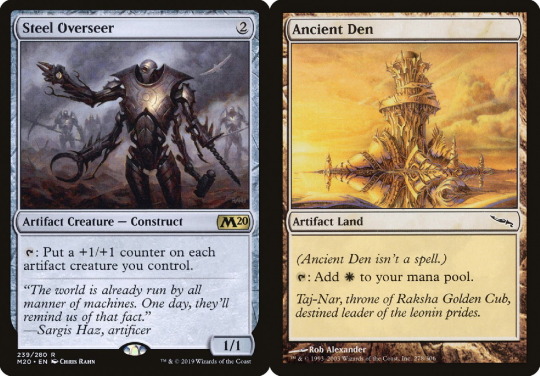
Artifacts can also come on the form of Equipment, which will give an effect when equipped to a creature. This often comes in the form of a buff to its power and toughness, but can also include adding keywords and other cool abilities. You’ll need to equip it by paying a cost, and can pass equipment around between any of your creatures. This can result in some funny mental images, such as a cat wearing a suit of armor and wielding three swords!

Enchantments are similar to artifacts in that they sit on the battlefield and have an effect, but they will have color. Also, Green and White excel at “cleansing” both by destroying them, but Red is only good at blowing up artifacts - after all, an ogre with a mace can smash a rock, but not a mystical spell.
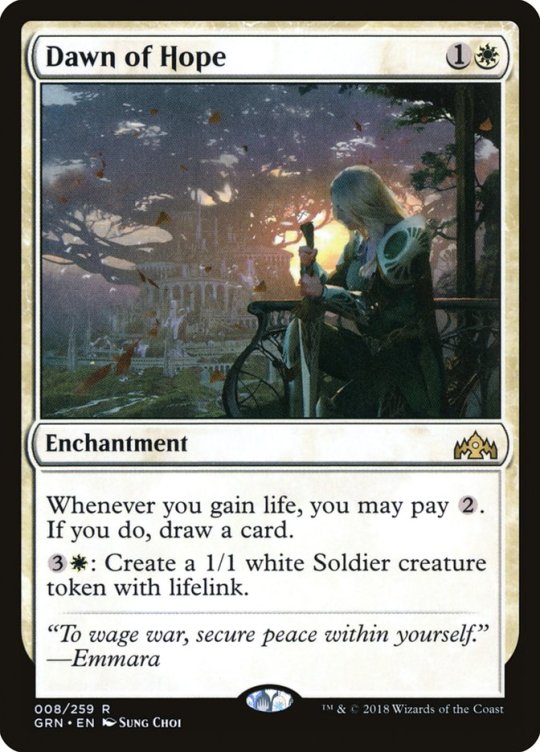
Some enchantments have the subtype Aura. This means you cast them targeting a specific permanent, and they will enter the battlefield attached to that permanent like a piece of Equipment. These, however, can’t be moved around, and will fall off and go to the graveyard if the thing they enchant ever leaves the battlefield. Auras will often buff creatures, but can also subdue permanents or boost a land’s mana production.

Planeswalkers are the newest and arguably the most powerful of the permanents. They represent the primary characters of MTG lore, beings who have incredible magical prowess and can teleport from plane to plane. They are (as of yet) all legendary, and thus you can only have one of each at a time on the battlefield.

They look pretty weird, don’t they? Instead of a power and toughness, they have a loyalty in the bottom right. Each planeswalker will enter the battlefield with that many loyalty counters on it. You can activate one of its abilities on each of your turns by adding or subtracting the indicated loyalty. Once a planeswalker is at zero, it dies and goes to the graveyard (or rather, gets fed up with your mishandling and teleports away, as per loyalty flavor). Planeswalkers can also be killed by spells that specifically target them, when they’re dealt damage, or when they’re attacked by creatures. Their last ability is often incredibly powerful, and is called an “ultimate”. Newer planeswalkers sometimes also have static abilities.
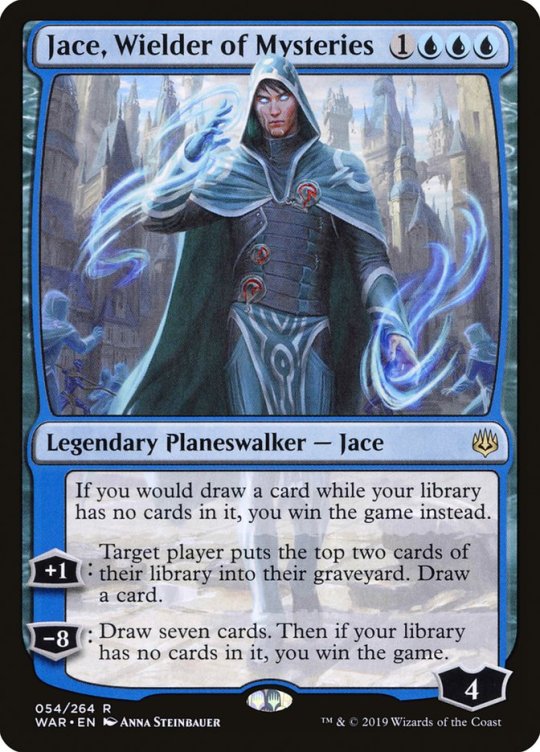
Planeswalkers are not creatures, and can’t attack or block. That being said, there are some planeswalkers that can turn into creatures.
Permanents are very useful, as they stick around and provide value turn after turn. Many strategies revolve around certain tribes, or using artifacts. Creatures are the main way to get damage through to your opponent to win the game. And planeswalkers have powerful abilities, requiring an answer from your opponent to stay in the game.
5. Spells
As stated above, all nonland cards are technically spells when cast, but here we will talk specifically about Instants and Sorceries. We will also define timing, as instant- and sorcery- speed is something we will discuss often when looking at casting spells, activating abilities, and using the stack.
Sorceries are your basic single-use card. Pay their cost, they’ll resolve, and you’ll get their effect once before they go to the graveyard.

Something I haven’t brought up yet is when you can play cards. We’ll go over the turn structure more in depth, but for now, know there’s a beginning step, a main phase, a combat phase, and a second main phase. You can play any of the previously mentioned cards, including sorceries, and activate planeswalker abilities, whenever it’s your main phase and the stack is empty.
The Stack: Whenever you cast a spell or activate a non-mana ability, or a triggered ability triggers, it will go on the stack. Things on the stack resolve last-in, first-out.
Instants are just like sorceries, but you can cast them at any time you have priority. This means they can go on the stack above other spells, which allows them to interact with other spells. Activated abilities can also be activated whenever, except for planeswalker abilities and those which specify otherwise.
Priority: When you have priority, you will have an opportunity to cast spells, play lands, and activate abilities. Everyone gets priority every phase, and it starts with the active player (whoever’s turn it is) and is passed around in turn order.
Whenever something goes on the stack, priority is passed around as well. Once each player has passed priority, it resolves and priority is passed once again for the next thing.
You can hold priority to cast multiple spells in a row.
Here’s a quick example to see how spells, abilities, and priority all interact on the stack:
Johnny and Timmy are playing each other, and it’s Timmy’s main phase. Johnny has a 0/2 Incubation Druid.
Timmy plays a Bala Ged Scorpion, which goes on the stack. Priority is passed around and it resolves. Its triggered ability goes on the stack, and Timmy targets Johnny’s Incubation Druid, since its power is 0, less than 1.
Since the ability is on the stack, Timmy gets priority and passes it to Johnny. In response, Johnny casts Burst of Strength, maintains priority, and casts a second Burst of Strength. Now priority passes between them for both, and they both resolve. Incubation Druid is now a 2/4.
Priority passes for Bala Ged Scorpion’s ability, but since the Incubation Druid now has more than 1 power, the ability does nothing and fizzles.
Fizzle: A spell whose target is no longer legal does nothing when it resolves. This is colloquially called fizzling.
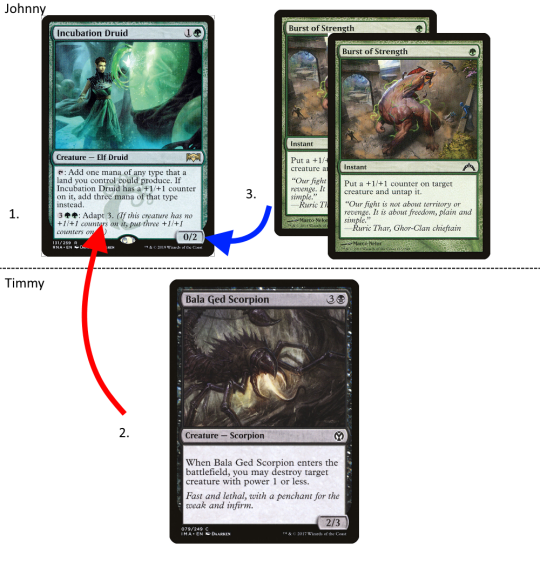
Assuming he had the mana for it, Johnny could also have activated Incubation Druid’s Adapt ability in response to the Bala Ged Scorpion, making it a 3/5 and also letting it survive.
There are lots of cool things you can do with the stack, such as making slick plays to foil your opponents’ spells or to copy big spells for massive value.
Some permanent cards have Flash. This is a keyword ability that lets you play the card as if it was an instant. Teferi, Mage of Zhalfir is the quintessential Flash card, as it also gives your other creatures flash and prevents your opponents from playing at instant speed.

6. Where are We?
I’ve been throwing around terms such as Graveyard and Battlefield, so what exactly do these mean? Well, these are all zones. We’ve already looked at one zone - Exile. The Stack is also a zone.
A zone is a place where cards can exist. They may have abilities that work while in that zone, most often on the battlefield. Public zones are where all the cards are known. This includes the Battlefield, the Graveyard, and Exile.
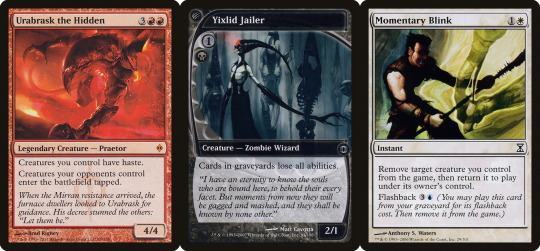
Urabrask’s ability only works while he’s on the battlefield, and only creatures you control on the battlefield would get haste - after all, those are the only ones who can use it, anyways. Yixlid Jailer takes away abilities from cards in graveyards, so Momentary Blink would not have Flashback while it’s there. Momentary Blink also exiles a creature (using the old wording of “removed from the game”) and brings it back, known as flickering.

Private zones are anywhere where cards are not public information. This includes your hand and your library. Thoughtseize, and other similar hand disruption spells, let you take a peek at what your opponent has. Loads of cards like Armillary Sphere let you search your library for cards. Others may reveal the top card of your library, or let you look at the top few.
It’s also possible to have “hidden” cards in public zones. Willbender feature the Morph mechanic, which lets you cast it face-down as a 2/2 creature. This means your opponent won’t know what it is until you turn it face up, but you will. Other effects might put cards face-down in exile, where you could cast them.
Whenever a card changes zones, it becomes a new “object”. That means all counters, equipment, and auras fall off, and it is no longer being targeted by anything that was targeting it before. A classic use of this rule is flickering a creature being targeted by a kill spell - even though it comes back to the battlefield, it is a new object and is thus no longer being targeted by the kill spell. The spell will fizzle and your creature will be safe.
7. Starting the Game
Ok. So you’ve got a basic understanding of all the cards and the different locations.��How do you get started actually playing?
There are lots of ways to play the game, but I’ll start out with the most common: a 1v1, best of 3 duel. This will also get a little bit into deckbuilding, but there’s a lot more on that later.
Most 1v1 decks will be 60 cards. In fact, this is a lower limit, and you can have as many cards as you want, but it’s convention to stay at 60 cards to maintain consistency. In a best of 3 match, you will also have a sideboard - 15 or less cards that may target specific strategies such as graveyard decks or artifact decks. After your first game and seeing what your opponent is playing, you’ll be able to switch out cards in your deck for the right silver bullets for games 2 and 3.

Common sideboard cards against Burn, graveyard, and artifact strategies.
If you’re playing a casual game with a friend, feel free to omit the sideboard, but it’s a staple part of competitive play and is a fun way to personalize decks in strictly defined metagames.
Now that you’ve got a deck (and presumably, a friend with a deck as well) shuffle up. Cut your opponent’s deck by putting the top half on the bottom (a customary ritual to prevent cheating) and let them cut yours. Figure out who’s going first by rolling some dice (whoever wins gets to choose, but generally going first is preferred), and draw seven cards.
You may not like your hand for several reasons. Maybe you have too many lands, or none at all. Your lands might all produce the same color of mana instead of all the colors you need, or you might have only highly-costed spells and nothing to do on your early turns.
No problem, just shuffle it back in and draw seven more. This is called mulliganing. You can do this as many times as you want, but don’t be too hasty, because once you find a hand you like, you’ll need to put one card from your hand on the bottom of your library for each time you mulliganed.
Now it’s time for your first turn. But before we really get playing, let’s look at the structure of a turn.
8. Phases of a Turn

credit to u/paper_alien
From this fancy diagram, we can see that your turn is broken down into roughly three different parts. I’ll be including examples of cards that interact with each phase. First is the beginning phase.
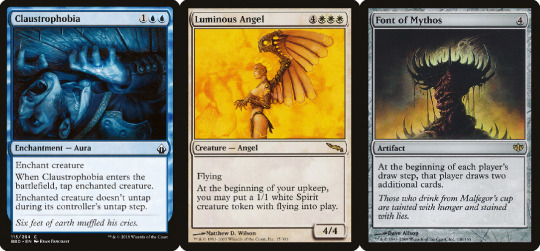
Your untap step is right at the start, when all your permanents untap. Simply turn them right-side up. Claustrophobia would prevent one of your opponents’ creatures from untapping, rendering it useless as an attacker and blocker, as well as preventing its tap abilities from being used. No player gains priority during the untap step, and play immediately proceeds to the upkeep step.
Normally, nothing happens here, unless an ability triggers. For example, the Luminous Angel gives you a 1/1 token on your upkeep. Players will get priority, so you’ll have a chance to cast instants or activate abilities as well.
After that is the draw step. You immediately draw a card, and abilities like that of Font of Mythos will trigger. Again, priority passes around. Once you’ve finished with the draw step, move on to your main phase.
Side note: Normally, players will typically condense these three steps into one (untapping and drawing), because it’s rare that you do play something here, but the steps are distinct for those cases in which you do need to take an action.

As mentioned above, your main phases are the only times you can play lands and non-instant spells, as well as activate planeswalker abilities. They sandwich your combat phase. It’s uncommon for cards to trigger during your main phases, but the two above are prime examples of such cards. Many activated abilities will also have an explicitly written restriction to only use them during your main phases.

The combat phase is the most complex, as it is really made up of five to six distinct subphases. First, you declare that you are going to move to combat. This will trigger cards like Hazoret’s Favor, and will give your opponents an opportunity to subdue your creatures before they can attack but after you have a chance to cast relevant non-instant cards.
Once priority is passed around, you move to the Declare Attackers step. Here, you will tap each creature you want to have attack, meaning you can only attack with untapped creatures, and declare the player or planeswalker it will be attacking. Creatures do not attack other creatures (this isn’t Hearthstone), and instead your opponent will have a chance to block your creatures with their own.
This happens after priority is passed around and you move to the Declare Blockers step. Your opponent will choose which of their untapped creatures they want to block your attacking creatures. Each creature can block up to one other creature, but any number of creatures can block one creature.
Next is the Damage step. Here, each unblocked creature will deal damage to the player or planeswalker it’s attacking, and each blocked or blocking creature will deal damage equal to its power to the creature(s) it’s been pitted against. If one of your creatures is being blocked by multiple, you need to divide its power among them. For example, a 3/3 being blocked by two 2/1′s must deal 1 damage to one and 2 damage to another. All creatures who have been dealt more damage than their toughness die and are put into the graveyard.
The theoretical sixth step actually occurs before the Damage step - the First/Double Strike step. If any creatures with first strike or double strike are involved in the combat, this step will be created and those creatures will have an opportunity to deal damage before other creatures. For example, if a 5/1 with first strike is blocked by a 3/3, the 5/1 will deal 5 damage to the 3/3 before it has a chance to fight back, and the 3/3 dies. Double strike means the creature deals its damage twice - during this phase and the regular combat phase.
Finally is the End of Combat step. Similarly to the Beginning of Combat step, this is mostly a formality, but some cards do trigger here (such as the Wall of Cinders), and priority is passed around.
Notice that you also get priority after every one of these phases, meaning you have tons of control over what happens. This allows you to play combat tricks. For example, say you attack with a 4/4 and your opponent has a 4/2. They might think you just want to trade creatures (meaning both die) and blocks your attacker. Before damage, you have a chance to play Giant Growth, pumping your creature out of range of your opponent’s creature, so yours survives.

This is also a great time to cover the keyword abilities I’ve been bringing up throughout, as many of them concern combat. Many of them are fairly self-explanatory, and are not exclusive to creatures.
Deathtouch: Whenever this creature deals damage to another creature, that creature dies.
Defender: This creature can’t attack. Often seen on Walls.
First Strike/Double Strike: As mentioned above, these let the creature deal damage before other creatures. Double Strike means it deals damage twice, once in the first strike damage phase and once in the regular phase.
Flash: You can play this card at instant speed. Can appear on any permanent card.
Flying: This creature can’t be blocked except by other fliers and creatures with Reach.
Haste: This creature isn’t affected by summoning sickness.
Hexproof: This can’t be targeted by your opponents’ spells and abilities. This doesn’t prevent it from being affected by “choose” or “all” effects.
Indestructible: This can’t be destroyed by damage or effects that say “destroy”. It can still be sacrificed, exiled, or given -X/-X to reduce its toughness to 0.
Lifelink: Whenever this deals damage, you gain that much life.
Reach: Can block creatures with flying.
Shroud: Like Hexproof, but also prevents you from targeting it (for example, with a pump spell or equipment).
Trample: Excess combat damage can be dealt to your opponent. However, you still need to deal lethal damage to any blockers. For example, a 5/5 with trample being blocked by a 2/3 must deal at least 3 damage to the 2/3 so that you can deal 2 damage to your opponent.
Vigilance: This creature doesn’t need to tap when attacking.
Menace: This creature must be blocked by at least two creatures.
There are many, many more keyword abilities, but these are the most common - the rest you will come across as you explore the different sets and planes.

After your second main phase comes the end step. In reality, you’ll care more about your opponent’s end step, because it is the optimal time to play removal, card draw, or other useful instants because it will give your opponent the least amount of time to react before your next turn. However, once priority is passed during your end step, check if you have more than seven cards in your hand - the maximum hand size. if you do, the cleanup step is created. Here, you must discard down to seven cards, and there will be another chance for priority after that. Seven is the default maximum hand size, but there are many cards that let you play around with that.
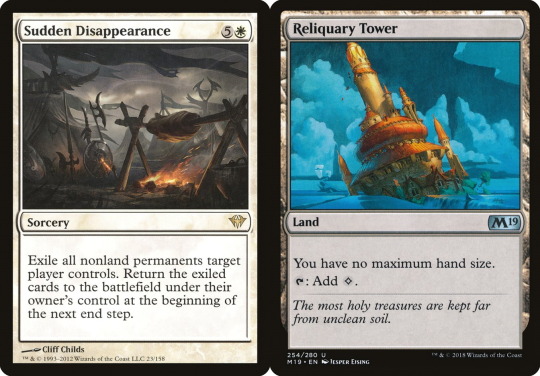
So now you’ve got your deck, you’ve mulliganed as you need, you’ve played an Island. I see you preparing to cast that Opt - but wait! Casting a spell is quite a bit more complex than it first seems, so let’s go over that now.
9. Casting Spells and Activating Abilities
All this time, I’ve been talking about casting and activating without really explaining exactly what that means, so now let’s make sure you know what that means. There is a lot of nuance to properly casting a spell, but once you understand it, you can ignore all the decorum in most cases. However, it’s still important to know exactly what happens to prevent common misunderstandings, and because Magic is full of strange cards that love to bend the rules; you will doubtless find fun corner cases.
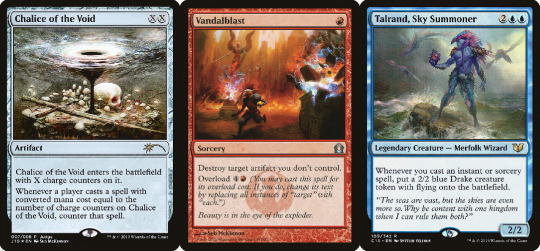

The steps to casting a spell and activating an ability are identical except the first, so I will be going over them together, referring to casting a spell.
Declare you are going to be casting the spell by putting it from where it is (generally, your hand) onto the stack. An ability will be put onto the stack as an arbitrary object.
Declare all the additional and alternative costs you wish to pay (for example, Vandalblast’s Overload cost), the mode of the card for split cards (such as Assure // Assemble) and double-faced cards (such as Alrund, who is also a bird on his other side!), and define the value of X (such as for Chalice of the Void), which you can pay for in mana of any color.
Choose the targets of your spell. You must have a legal target for each time the word “target” appears on the card (this is when effects such as “When this becomes the target of a spell” are triggered and go on the stack, to be sorted out and resolved later).
Now determine how much you need to pay. This includes cost reductions and additional costs, such as for Torgaar, as well as taxing effects (i.e., “noncreature spells cost {1} more to cast).
Activate mana abilities, such as those from your lands and mana rocks, and pay all costs as required. This means, for example, that you can tap a creature that produces mana and sacrifice it to pay for Torgaar.
Congratulations! Your spell or ability is now on the stack. Abilities that trigger while you are casting your spell, such as Talrand’s, will be on the stack above it and will thus resolve first. We covered fizzling before, but to clarify, a spell will fizzle only if all its targets are no longer legal, either through dying, or gaining Hexproof, or some other means. This means you get no part of its effects. If it has multiple targets, and only some become illegal, the card resolves as normal.
Like I said, you really don’t need to understand all of this in depth, but it helps clarify the occasional odd rules interaction.
10. Abilities
There are four types of abilities that you might find on cards. The one we’ve just covered extensively was activated abilities, which further come in two forms.
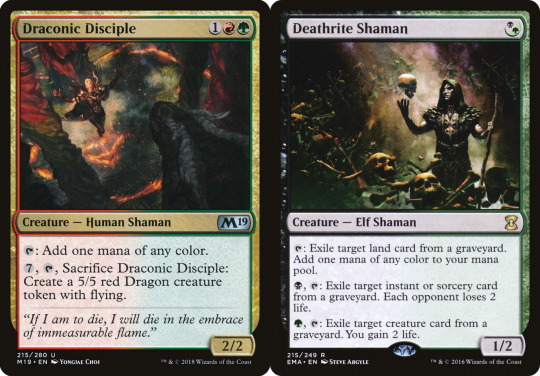
Draconic Disciple handily features both: a mana ability, and a normal activated ability. Notice that all activated abilities use the syntax “Cost X, Cost Y: Ability.” As we covered last chapter, you need to use mana abilities before paying costs when activating an ability, so you couldn’t tap Draconic Shaman for mana for his own ability as well as tap him to summon the dragon.
The main distinction for mana abilities is that they don’t use the stack, resolve instantly, and can be used while casting spells. An activated ability is considered a mana ability if and only if all it does is create mana. That means that Deathrite Shaman’s first ability is not a mana ability, because it exiles a land in addition to creating a mana.
The three other types of abilities are triggered abilities, passive abilities, and replacement effects.

Vanquisher’s Banner features a passive ability by giving all your creatures of a certain creature type +1/+1. It’s pretty straightforward: a static ability simply applies as long as the permanent which has it is on the battlefield. There are nuances in “layering”, but this is already far more complex than you’ll need to know for the majority of games. Feel free to read that article, though.
Vanquisher’s Banner’s third ability is a triggered ability - an ability that goes on the stack when something happens. This could be casting a spell, a creature entering the battlefield, or drawing a card - or just about anything. These are generally in the form “When” or “Whenever”, and should not be confused with replacement effects.
Replacement effects, like the one seen on Teferi’s Ageless Insight, come in the form “If... would... instead”. They are similar to triggered abilities in that they occur in response to something happening, but they don’t use the stack. Instead, think of them as modifiers to abilities. For example, if Teferi’s Ageless Insight was formatted like a triggered ability, drawing you a card each time you drew a card, you’d be stuck in an endless loop of drawing. Instead, replacement effects only apply once to each thing they modify.

There are many ways that abilities might manifest themselves, and they don’t always need to be on the battlefield. Bridge From Below’s wall of text works when it’s in the graveyard. Skyscribing’s ability only works from your hand, and is keyworded by Forecast, which only appeared in the original Ravnica set.
The best way to experience all the different interesting abilities and cards is just by playing and expanding your collection. Enjoy playing around and learning more about the game.
This is just about all you need to know to understand the game itself. However, Magic cards just love bending the rules, so you’ll always be encountering interesting rules interactions that will teach you more about the game as you play.
11. Formats
Here is where the fun really begins. Choosing a format is like choosing a social media platform: it comes with its own drama, flavor, speed, and player personalities. All formats use 60 card decks with 15 card sideboards, and start at 20 life, except Brawl and Commander. Each format has its own banlist, so make sure you check that before building just any deck. However, feel free to totally disregard all formats and just build whatever deck you want to have fun with friends!
Here are the most popular formats:
Standard: Probably the most popular 1v1 format, Standard uses cards from the last few sets, and constantly rotates. Deck prices can range from under 100$ to over 500$ when certain powerful cards are in rotation, but when a card rotates out, it can lose its value if it isn’t played in older formats. It can be competitive, but also lets you play with fun new cards in a weaker environment.
Pioneer: The newest official format, Pioneer uses cards dating back to the set Return to Ravnica. It has the same fresh feel as Standard, but doesn’t rotate and is closer in power level to Modern.
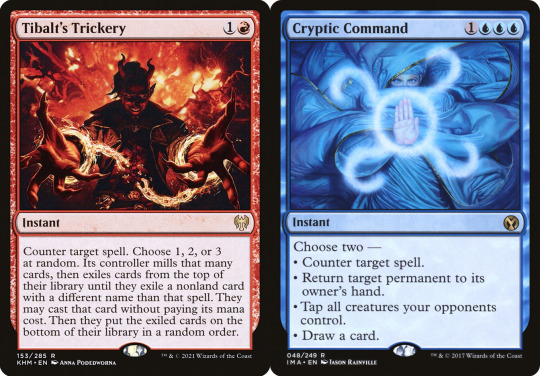
Modern: This format uses cards from the newest set all the way back to Eighth Edition from 2003. Decidedly more powerful than Standard, and expensive as well. Competitive decks can range from 200-1000$, but the vast size of the card pool means you can find budget builds and underdog decks to tinker with.
Legacy: You can use any card in the history of Magic, except those from the Banlist. The power level is incredibly high, yet the stereotype of 2-turn games is not as true as one might think. Because of the original dual lands, decks are often over 1000$, but mono-colored decks such as Burn can be brought down to 200$. Definitely not for the faint of heart.

Vintage: Like legacy, all cards are at your disposal, and this time, instead of a banlist, you have a restricted list, meaning you are limited to 1 copy of certain cards. A single copy of Black Lotus can be tens of thousands of dollars, and is a staple alongside the rest of the Power Nine. Very few play it because of the price tag, but it lets you tap into the true power of the oldest Magic cards.
Commander (AKA EDH): Play with any card, like Legacy, but with the distinct Commander banlist. The deckbuilding process here is very different: Pick a legendary creature you like, and pick 99 more cards that are of the same color(s) as your commander. This is a singleton format, meaning you can only have one of each card except for basic lands. Commander is also a multiplayer format, played in pods of 3-6; most often 4. Your commander starts in the Command Zone, where you can cast it. Each time it dies, it goes back to the Command Zone, where you can replay it for an additional 2 mana each time. The multiplayer nature, 40 starting life total, and high variance make Commander incredibly casual, much more a social event than a game. Have fun casting huge spells, playing pet cards, and embodying your commander. That being said, there’s a competitive scene in EDH, known as cEDH.
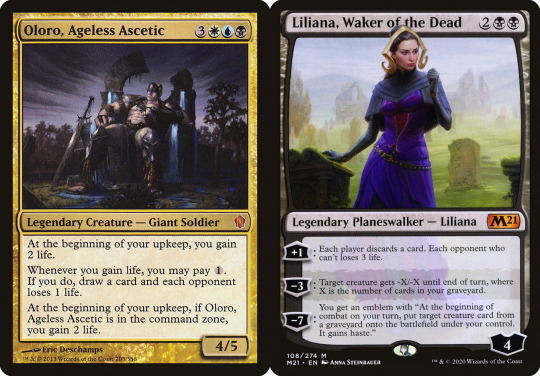
Brawl: Ah, Brawl. Commander’s younger, forgotten brother. It’s a cross between Commander and Standard, in which you have a commander (in this case, it can also be a planeswalker) and must have singleton copies of cards. Like Standard, you can only use cards from the last few sets, your deck is only 60 cards (no sideboard, though), and games are 1v1. You start with 25 life. Almost nobody plays this in person, but it’s very fun on MTG Arena.
12. Where to Play
Assuming you don’t have a group of friends ready to accept you into their playgroup, finding people to play with can be hard. First, I’d recommend checking Wizards of the Coast’s official Store Locator to find local game stores that might be hosting events and selling cards. If you go to their websites, they’ll often have calendars listing events by date, format, price, and prize. Explore and find one you like. MTG players are generally friendly, and will be willing to accept you into their playgroup, teach you about the game, and maybe even let you borrow a deck!
If you don’t feel like playing in person, there are several online options.
Magic Online (AKA MTGO or MODO) is the primary official way to play. Pay 10$ for an account, and you can buy, sell, and trade cards as if they were real. No really - Magic cards are almost like stocks, and MTGO cards are basically digital versions of Magic cards, so their price will generally mirror their real world counterparts, albeit at a lower price.
Magic Arena (MTGA) is the newest official online game. It only has cards from recent sets, back to Kaladesh, as well as a few odd cards hand-picked for Historic play (a format specific to the game that uses all cards available). Because of the smaller card pool, MTGA is limited to Standard, Brawl, and Historic as the primary game modes. However, it is free to play and your collection can’t be traded, so you collect cards somewhat like Hearthstone.
There are also a few unofficial programs, including Untap.in, XMage, and Cockatrice, which are free and give you access to the full range of cards for testing new decks before you buy them in paper.
Make sure you keep track of MagicFests, official conventions hosted both around the world and online, to meet tons of new people and play in competitive events.
Ultimately, though, many people choose to play at home around the kitchen table with friends and family. Play wherever and however you feel most comfortable; after all, Magic’s best aspect is self-expression.
13. Accessories

Credit: Tolarian Community College
If you’ve visited a local game store by now, you may have noticed that they sell way more than just cards. There are a myriad of accessories you can use to personalize your game and protect your cards.
Dice: from D4′s to D20′s, you can find these in countless colors and styles. Have fun picking your favorite and use them to keep track of life totals, counters, tokens, and more.
Sleeves: These can come in many different colors and designs, but vary wildly in quality. Pick the ones that feel right for you. These will help you shuffle your deck with ease and prevent your cards from getting damaged. Inner and outer sleeves provide additional protection for your most valuable and prized decks.
Deckboxes: Again, tons of variation. The right deckbox for you will depend on how many cards you want to fit in it, if you want space for dice, the design, and much more.
Playmats: These provide a sleek surface for you to easily pick up, tap, and move your cards around. Pick ones with your favorite Magic art, or order one with your own.
Trade Binders: Once you’ve built up a collection, you might have a few valuable cards you want to show off. Put them in a trade binder, and approach people to find other neat cards you might need.
Tolarian Community College on Youtube provides the best reviews of popular accessories, rating and testing them thoroughly. He also dishes out incredible commentary on new sets and the state of the game. Probably the most popular MTG Youtuber out there.
14. Further Resources
You’ve made it this far, but there’s still so much to explore! Here, I’ll be listing plenty of websites that are excellent resources to expand your understanding of the game.
The official rules: Quite dry, but this is where to go if you ever find a confusing interaction.
Tolarian Community College: I just discussed him, but I must reiterate how awesome his channel is.
Scryfall: A powerful search engine for all the Magic cards you might be looking for. What I’ve been using for card images this whole time. WOTC’s official Gatherer pales in comparison.
TCGPlayer: My favorite way to order cards online, but alternatives include Card Kingdom, StarCityGames, and ChannelFireball.
MTGGoldfish: An excellent all-round resource for keeping track of metagames, card prices, and interesting articles and gameplay. You can also use it to find, build, and share decks and see their prices.
EDHREC: This site conglomerates EDH decks from around the internet to give you a condensed list of the best cards by commander. A must-have resource when building new commander decks.
Last but not least, the best way to learn to play Magic is to watch others. I started out by watching gameplay from Grand Prix’s and other competitions on Youtube. Even though I barely knew what the cards were, I quickly picked up the most popular ones, learned common play patterns, and more. You don’t need to be a pro to learn from them.
15. Have Fun!
Yeah, it’s cheesy, but as I’ve reiterated, Magic is a game of self-expression. With thousands of cards to pick from, plenty of formats, styles, and accessories, customize your play experience as much as you want and be comfortable with that. Meet new people, participate in trading, and play in local events. Magic is what you make of it, so make it the best it can be.
30 notes
·
View notes
Photo

The Lancejaw Manticore is a coastal member of the manticore family, its territory spread across seashores, estuaries and other ocean side environments. Of these habitats, it prefers those found in tropical climates, where warmth and water is always abundant. Though its home is always close to seawater, the Lancejaw is not an aquatic creature. It instead stalks the shorelines and surrounding areas, looking for potential prey. This does not mean, however, that the Lancejaw avoids the water. Unlike its brethren, this species is resilient to salinity, and can actually wade through the shallows without any ill effects. This also means they have a slight resistance to the salt deterrents that folks use to ward off other manticore species, which can be a problem! Anyways, the Lancejaw will go into shallow water to either catch aquatic prey or pursue fleeing food. It should come to no surprise that these manticores are predators, and deadly ones at that! Unlike the more common manticore, Lancejaws do not actually fire spines from their tail. Yes, this appendage is quite spiky and is indeed covered in paralyzing venom, but these spines are permanently attached. They have a much stronger base to them, thus making them a rather solid melee weapon. While these spikes cannot be launched or thrown, they can still be swung around and stabbed into vulnerable flesh. For long range combat, their weapon of choice is instead located near their face. If you remember from other manticore species, they possess a pair of facial tendrils that end in venomous barbs. For the Lancejaw, these have been highly modified into a completely different weapon. Instead of one permanent barb, these appendages instead grow many jagged spears that jut from the orifice. The growth of these lances is quite quick, but not nearly as fast as the tail barbs of a normal manticore. This means that their ammo does not refill as fast, so they need to be more accurate when hunting prey. They achieve this by using special organs that are found where the spears grow. When a Lancejaw is ready to attack, these organs will use a flexible tube to attach to the base of one of these lances. By inflating with air, it will build up pressure and use it to launch this single jagged blade. This shot is incredibly accurate, and it can go farther than a normal tail dart. Their accuracy and range can rival that of a crossbow, which is bad news for their prey! What makes things worse is that these spears are coated in the same paralytic venom, which quickly brings down targets. Those who are struck only have minutes to escape before they lose full control over their limbs. Even then, you will find flight quite difficult when your parts slowly shut down and become useless. And all the while, the Lancejaw will be patiently plodding behind you, waiting for you to inevitably drop. They know when a shot has connected, and they know they only have to wait for dinner to be served. Like mentioned above, Lancejaws hunt their prey by firing these paralyzing arrows at their prey. They will usually creep up to firing range and then attack when the time is right. This goes for both land and sea creatures! In shallow rivers, the Lancejaw will go after fish and other aquatic animals, firing into the water and then swallowing whatever floats up. As usual, the Lancejaw swallows its food whole, its flexible mouth and stomach allowing it to eat hefty meals! When engorged, it will slink to some warm sunny place to lie, slowly digesting its kill. Due to its limited ammo, Lancejaws appear more cautious and coordinated than other manticores. They know they only have a certain number of shots, and that they cannot afford to fire recklessly. This means they will take longer to strike, as they are lining up a shot. Even if they do run out, though, do not think they will give up. Their permanently spiny tail is their backup, and they can use it with lethal force.
An interesting thing to note about their facial weaponry is that it seems to have developed to help them hunt in aquatic areas. The tail barbs of other manticores would fail to reach prey that was underwater, as they are not launched with enough speed or force. These special organs they have essentially allow them to go spear fishing! Another thing they help with is dealing with the Pedunkas that stalk the shores. These barnacles-encrusted Slimes are opportunistic scavengers, but they can compete with a Lancejaw for food. While other manticores would have a hard time penetrating thick slime, the Lancejaw has been shown to be capable of such a feat! Their spears can shoot through the pseudobody and pierce the heart, injuring or killing the Slime. This gives them the ability to ward off Pedunkas and keep them from stealing their kill. As a result, Pedunkas tend to avoid Lancejaw territory, and they will be hesitant to challenge one. For people who live on the coast, they like this idea. "Beaches with no Pedunka? What a dream (Is what they would say, not me)!" Unfortunately, this comes with them being smack dab in Lancejaw territory, which leads to obvious problems. Like their brethren, Lancejaws are incredibly dangerous and are widely feared. Anything they can swallow is seen as prey, and they won't pass up a chance for a meal. Their territory is given a wide berth, and many avoid the shores when a Lancejaw is on the prowl. Despite their deadly abilities and carnivorous diet, Lancejaws also have a bit of popularity. It appears that they have developed as symbols of wealth and power, due to their striking colors, gorgeous shells and sharp cunning. What further cements this is how valuable their parts and pieces are. The shelled parts of a Lancejaw fetch a tidy sum, as their pearly sheen and vibrant coloration makes them instant art. People can carve them into jewelry or breathtaking sculptures, while some just mount the polished piece as a whole and call it good. Every bit of shell is valuable, but their headshell is the most desired part. Its size, complexity and ornateness make it a must-have for any collector or wealthy show-off. The other thing that makes them so valuable is their fragility. Due to their aggressive lifestyle, Lancejaws will often break off the long thorny spine that grows off their headshell. This part will grow back over time, but it won't look nearly as good as the original. Thus, people go crazy over intact headshells, as they are incredibly rare and incredibly difficult to obtain. If you can somehow find a Lancejaw with a flawless headpiece and then bring it down without damaging it, you will be drowned in gold for your efforts. Besides their shells, Lancejaws are also valued for their special mucus. Certain glands in their body create mucus that they use for marking territory and coating their mouths, and this fluid can be used to create a unique dye. The dye that comes from this lengthy process is a brilliant purple, one that is impossible to replicate and impossible to ignore. The shade it creates is unique and quite iconic, making it a color used by the wealthy and powerful. Due to its rarity and price, very few have access to this dye, especially since it means killing a Lancejaw to obtain it. I guess that is one of the things I appreciate about these beasts. While other poor creatures are overharvested to make fancy decorations for rich jerks, the Lancejaws are ones who fight back. And most of the time, they win. Chlora Myron Dryad Natural Historian ------------------------------------------- Another species of Manticore, because literally every monster needs different variations and forms! This critter was further down my posting line up, but I actually decided to post it now because Iceborne is being released tomorrow and I figured I would show something that was inspired by MHW. It probably would have been more fitting to do fanart, but I kind of suck at that, so I went with a creature design I thought up of while playing the game. This fellow was inspired by the Coral Highlands, and I think he would fit right in!
45 notes
·
View notes
Photo





Some people really hate The Boys in the Band. The play, a seminal work that some credit with helping spark the Stonewall Riots, takes place at a birthday party, in which nine gay men gather, before the event devolves into an airing of grievances. And while it was considered revolutionary when it came out in 1968, many believed it should have stayed there. Vanity Faircritic Richard Lawson called the new production a “thoroughly hateful relic that serves zero purpose now.” For some, the only thing the play can do in 2018 is exacerbate stereotypes the gay community has fought hard to kill.
“I feel like a lot of people just have a problem with this show,” Andrew Rannells says, who stars as Larry, a bratty and rebellious man who’s a constant headache for his boyfriend, Hank. However, he thinks that might have more to do with the viewer than the work. “I think it can be looked at as a rather bleak depiction of what your life as a homosexual would be like. I think it got a bad reputation for a while. But I hope that this revival is at least in some way showing that it's actually funnier than people give it credit for, there’s more love between those characters than people remember.” We also have the benefit of new context, 50 years later. “It's not a representation of every gay person. It's a representation of nine people on this one night. At the time, it was a symbol for all gay people. It doesn't have to be.”
Rannells feels like at once like a rarity and like exactly the type of person works like The Boys in the Band were auguring—an out gay man who hasn’t been pigeonholed into playing the goofy gay best friend, but someone who hasn’t shied away from playing gay characters. He knows his history, he’s proud of it, and he wants to use it to do... well, everything. He’s dominated Broadway in shows like The Book of Mormon, Hamilton (heard of it?), and Falsettos. He’s starring in an upcoming Showtime series, Black Monday, about the stock market crash of 1987. He’s writing a memoir. But if there’s one thing many of his projects have in common, it’s a layer of controversy. And he’s not worried about that at all.
Rannells wants me to notice something. He gestures towards the photograph at the end of our booth here at Julius’, an iconic gay bar in the West Village. The black-and-white shot shows a group of men, all white and dressed in ties and sport coats, leaning over the bar as the bartender covers their drinks with his hands. It’s a shot from a “Sip-In” that took place in this bar, Julius’, in 1966. “Dick Leitsch is in that picture,” he says. “He started the Mattachine Society...That's a big part of the reason I wanted to do this photo shoot here, because he's been an amazing man and sadly passed away this past weekend.”
Rannells got to meet Leitsch a few weeks before his death, when friend and artist John Cameron Mitchell brought him to see The Boys in the Band. But Rannells has another connection to Julius’, the oldest gay bar in New York. In the 1970 film adaptation of the play, Larry and Hank are first shot having a drink there. “He was in this physical space,” Rannells says. “It's a piece of our history and that history.”
It’s impossible to watch The Boys in the Band without thinking of how much has progressed in the past 50 years. The anachronisms in the show (the references, the language, the stereotypes) serve to highlight just what has changed—and what has stayed the same. For instance, Rannell’s character, Larry, is living with a serially monogamous divorcee, Hank. But while Hank just wants love and commitment, Larry can’t be tamed.
“I feel like that's a conversation that couples still have today about monogamy and the idea that, as gay people, monogamy is something we should subscribe to—this heteronormative lifestyle and those rules and that shape of things,” he says. “I feel like that's still a very timely conversation that people have.” Another familiar trope? That the most effeminate of the group is the one who is disrespected the most. “There's an awareness in gay culture now, I think, of reconciling your feminine side with the masculine side, and being okay with the fact that whatever that means, however you interpret that, it's not that Masc4Masc thing that people talk about. Especially with younger gay guys, that's more of a thing that they're embracing. I think it's good. It's very good.”
At face value, The Boys in the Band could certainly seem to enforce outdated ideas of gayness. But a new generation also may not understand what was a stereotype and what wasn’t. In the show, Michael, played by Jim Parsons, is a depressed alcoholic who turns into the ringleader for the night’s chaos. In the '60s, it was more obvious to viewers that Michael was depressed because he’s gay. But now that’s not the case.
“We had a group of high school students come. None of them equated Michael’s character, his depression and alcoholism, with being gay,” Rannells says. “They were just like, ‘He's depressed,’ which I thought was some sort of progress, that they were not like, ‘Well because he's gay, that's why he's so messed up.’ They just thought he was a depressed person who happened to be gay.” Michael was no longer a symbol of the gay experience. He was just Michael.
Larry is tricky. Larry is bratty, constantly insulting his partner, threatening to leave or cheat, flirting in front of him to incite jealousy. It’s easy not to like Larry, because, as Rannells puts it, “you’ve either dated a Larry or you were a Larry.” But getting to the heart of these tricky men was an act of understanding history. “There's a sign somewhere in this bar actually, that says, I think, the law was one woman for every three men on the dance floor,” Rannells says. “The stakes just to socialize were so much higher, that that's something we talked a lot about in rehearsal.”
This illegality is hinted at in the play. Emery is roasted for getting arrested in bathhouses. At one point someone knocks on the door, and a character yells “Lily Law!” (polari for cops) and tells everyone they need to be three feet apart. And for Rannells, learning the role of Larry meant feeling that pressure, that paranoia, and knowing that it has to find a release, even if it’s not in the healthiest way. “We're very lucky that for all of the troubles, the fights that we still have to fight now, there's some fundamental things that are just much better for us now 50 years later,” Rannells says. “That's not to say there's not still a ways to go, but when you look at what those guys were doing 50 years ago, it's like, I can freely hang out with my friends at any bar, it's fine."
You wouldn’t know Andrew Rannells is almost 40. He’s got a smooth, boyish face, all cheeks and lips, and bouncing, thick hair. He’s ready to laugh at the slightest provocation, and moves with ease and excitement. His youthful energy is maybe what makes him so compelling—there’s a depth and wisdom that you don’t expect to come from it.
Right now, Rannells is channeling a lot of what he’s learned during his theater years into a memoir. The idea for the memoir began after he wrote a piece for Modern Love in the New York Times about his dad passing away. Transitioning into writing about things like family and hookups has taken some adjustment. “It's an interesting process to go through though, because you do have to be aware of the fact that you're telling your version of events,” he says. “You just have to be sensitive of the way that you portray it.”
Though it covers a lot of his life, much of his memoir will focus on his first seven years in New York City. Rannells moved here in 1997. He grew up in Omaha, Nebraska, attending Catholic school and waiting for the Tonys to come around every year. “It's hard to explain to kids now, but the Tonys only happen once a year, and there was no magical Internet YouTube where you couldn’t just be like, ‘What's a clip from a Broadway show?’ I really had to wait for a year to see. I would record them and then watch the same clips over and over. To get that new wave of shows, we had to wait until the following year. I didn't see my first Broadway show until I was 18.” For the record, it was Rent.
Rannells attended Marymount College for two years, at first living in a midtown dorm that fell apart on the students, and then in Brooklyn Heights. But after two years, he devoted himself to acting full time, and landing roles in animation voice work, regional theater, and as a Broadway understudy.
While many narratives are quick to frame the move to New York or Los Angeles as the “I got out and I’m going to make it” moment, the truth is there’s a lot of bad theater you have to go through before finding success. “My career didn't start with The Book of Mormon. I had a lot of time, things I was very proud of—maybe not huge successes on a larger scale, but they were a big deal to me,” Rannells says. “I think that's important to realize and to celebrate those things, because they're happening. It all does lead you to where you're going.”
It’s his ability to appreciate the weird and the small that’s perhaps made him so difficult to typecast. Though he’s spent most of his time in theater, the role he might be best known for is Elijah on Girls, a character that could have easily stayed the trope of the gay best friend, but who morphed into his own complicated, fully-formed person.
Rannells has learned how to be judicious about the roles he chooses. As Elijah, he “got to say some sassy one-liners, but I also have a full-internal life going on. But since then, anything that comes up, I do get offered a lot of gay friend things.” Which is not to say he only wants to play straight. He wants any character he chooses to be, you know, an actual person. And actually, it’d be cool if they were gay. “Before Girls, I really only played straight parts. I liked doing it. I was happy to get to be a part of their shows,” he says. However, “It's nice getting to play gay guys as a gay guy. I was going to say authentic, but that's not quite right either. It's more personal.”
Like The Boys in the Band (and The Book of Mormon, and Hedwig and the Angry Inchbefore it), Girls wasn’t everyone’s cup of tea. But that’s part of the appeal. “Those are the things that I like to watch,” Rannells says of being a part of productions that push boundaries. “I'm attracted to those stories—[Book of Mormon creators] Trey Parker and Matt Stone, and Lena Dunham, I think they have a lot in common, in that they write from their gut, they know that somebody is going to find this and get it. Not everybody does, not everybody respects it. But when people do get it and people locked into what Lena was doing, people love it.”
The thing is, Rannells has emerged unscathed. Sure, you might have hated Girls, but you liked him. You’re excited to see him in whatever he’s doing, both because he’s good at what he does and because you’re not going to see him doing the same thing twice. And now that he’s in the position to keep taking the interesting roles, he’s not going to stop. “I want to be in things that I want to see as well,” Rannells says. “I guess it’s as simple as that.”
5 notes
·
View notes
Text
The Value is in the Aesthetics: the Art of the Pokémon TCG
New Twitter account: @ArtofPokemonTCG
Hi guys. So here we are. An account dedicated to celebrating the art of the Pokémon Trading Card Game. The idea for this channel was primarily born from my love of, well, the Art of those lovely little rectangles of cardboard (that’s my wife’s description, substituting the word lovely for pointless) that we like to cherish. Some of said pieces of cardboard can even be special, sparkly ones (that’s what I tell my wife as an unexpected package drops through the letterbox and I try to justify spending more than I perhaps should have).
Despite having dabbled in the Online Trading Card Game on and off, I’m not much of a player. I prefer to collect. It all started back in 1999 with Base Set when I was about 12 years old and the Pokémon craze craze swept my school and every other school in Britain. But while I’d like to say I’ve been collecting ever since, the reality was that Pokémon just wasn’t seen as ‘cool’ when heading into your mid to late teens. And thus began my, what adult Lego fans call, Dark Age. But darkness can only have relevance in relation to light and the light was to make a brilliant return in my early 20s when I picked up Pokemon Diamond for DS. It was like picking up where I’d left off with an old girlfriend (my girlfriend at the time wasn’t happy when I described it like that)! But my itch to climb back into card collecting wasn’t scratched until about a year ago. The initial excitement of opening a booster pack came rushing back, followed by a pang of regret at not having the foresight to keep all of my old cards, but the elation at realising I had about 18 years worth of sets and expansions to wade through on eBay. To date there have been 74 total sets/expansions released with the 75th and 76th expansion of the current set due to be released before the end of the year. If we take the cards in those sets plus promos, the TCG now has nigh on 10,000 unique cards, give or take a few for reprints etc. (If anyone knows the precise figure, I’d love to know). Of course, there was no way in hell I was going to collect all of them, as
a) I’m a collector, not a completionist and b) I’m not rolling in cash.
The latter of the two arguably dictates how true the first is. Maybe if Pokémon cards were £0.50 per pack, I might be a completionist. But sadly they’re not that cheap; the reality is that this hobby has if anything become more and more expensive since my glory days in school. Booster packs, booster boxes, collection boxes, pin badge boxes, booster packs, elite trainer boxes. That’s a few hundred quid in that last sentence! Spending is a huge part of collecting in any hobby, but especially in this one. The rarest cards can fetch hundreds of pounds; the extremely limited Pikachu Illustrator Trainer card fetched more than £44,000 at auction. That’s an extreme example. Even if you’ve not got £50k kicking around, gathering dust in your bank account, a well looked-after Base Set Charizard could cost you in the region of £50 these days on the secondary market (shamefully, I traded mine for a holo Scyther after school one day; the excitement upon the release of the Jungle set led to a few silly decisions!) A sought after full art card, depending on rarity and set, can go for a more modest but by no means insubstantial £15 to £20.
So what’s all of this got to do with what this account is setting out to do: celebrating the Art of the Pokémon TCG? Well, there’s much more to collecting Pokémon cards than investment. Arguably, there is just as much enjoyment to be had from this hobby, regardless of whether you have your monthly pocket money to spend or have a full time job that affords you a little disposable income. Actually, I’ll retract part of that statement: Not arguably. Definitely. Regardless of value or rarity, all of the cards that you pull from your £3.99 booster pack are bound by one thing: the love that the illustrators pour into their design and presentation. I’ve always loved the artwork and aesthetics of other media. I’m no stranger to a video game art book and so Pokémon TCG was no different. The owner of my local card shop (sadly now closed as of yesterday) used to even keep a few cards aside for me, just because they might be of interest to me from an aesthetic point of view, and not just for his own commercial gain. But it was on one afternoon in particular that this idea of celebrating the art of the TCG really took root. Following a long spell of not having bought any boosters (13 packs of Burning Shadows in a row without a GX, Full Art or better had left a more than bitter taste in my mouth), I impulsively bought a Break Point blister pack. Blisters are not renowned for their good pulls but it was nicely reduced and I had my mind fixed on one of the many Full Art Mewtwos in that set. Nothing beats the thrill of breaking the seal on a booster, doing the card trick and seeing what happens. But there’s also no worse feeling than pulling three packs of absolute crap, which is exactly what happened. Feeling just that bit more bitter and remembering afresh why I had decided to stop buying booster packs, I decided to pick up my £9 worth of nothing and flick through what I’d pulled. Might as well get my money’s worth, I thought.
That was the moment.
I stopped to actually look at some of these cards more closely: the commons, uncommons, the non holo rares; all cards I would’ve rashly skipped over on my way to see if that elusive EX of any description lay hidden at the back of the pack. But while only lowly common and uncommon cards, some of these were nothing short of stunning with so much care and attention given to render them so vividly and really bring each Pokémon to life. The bitterness subsided and gave way to sadness. Not a '£9 down the drain’ type of sadness but one that spoke of booster pack openers across the world doing exactly the same as me and not giving the lesser cards the attention and love they deserve. And they do deserve it, since their illustrator no doubt devoted just as much attention and love to their design as they hoped we would pour into appreciating them. And I know for one that that doesn’t always happen. The most damning example of this is a recent feeling of disappointment I experienced at only pulling a rare holo from a pack. That was another big moment since I started collecting again. A stop moment. Way back when Base Set fever was sweeping every playground in the land, holos were the pinnacle. I remember being so proud to own my 1st edition Machamp holo, which was dime a dozen since it came in a starter deck. But it was a cool card and I whooped at pulling it as part of the Evolutions reprint again almost 18 years later. So, to go from this to now resenting a holofoil card, just because it wasn’t the EX, GX or Hyper Rare I was craving. It seemed that somewhere along the way a perversion of values had taken place as to what constitutes true satisfaction from a set of pulls. Value, rarity and status had trumped the true value of aesthetics. I know there is some crossover there too though: an ultra rare card can also be truly stunning. I’m not going to lie and say that I now throw all of my ultra rares in the corner because 'look at the pretty colours on this Caterpie’. I have many Full Arts and a few Hyper Rares which I really love. But my point is this: let’s not ignore the Magikarps, the Polywags, the Hoot Hoots, the Mudbrays just because of their circle or diamond symbol. Stop and have a closer look. Think about how someone somewhere thought to capture this particular Pokémon in this particular pose, on this particular backdrop and that that person was fortunate enough to have their work placed on a card for the world to see.
To quote Novellist Julian Barnes:
“Art belongs to everybody and nobody. Art belongs to all time and no time. Art belongs to those who create it and those who savour it.”
Never have truer words been spoken. My hope in creating this account is to celebrate the art across the entire TCG; not only cards across generations but also from Commons to Hyper Rares, not celebrating their status as such but rather what our senses first latch onto above all else: their aesthetic value. I hope to do this through posting pictures, offering personal reflection on selected cards while also inviting you to share with me your highlights from the TCG.
Thanks for reading and enjoy. Please follow, like and retweet. Spread the word. Art belongs to everyone. Pokémon can too. And you don’t even have to catch 'em all to do it!
0 notes